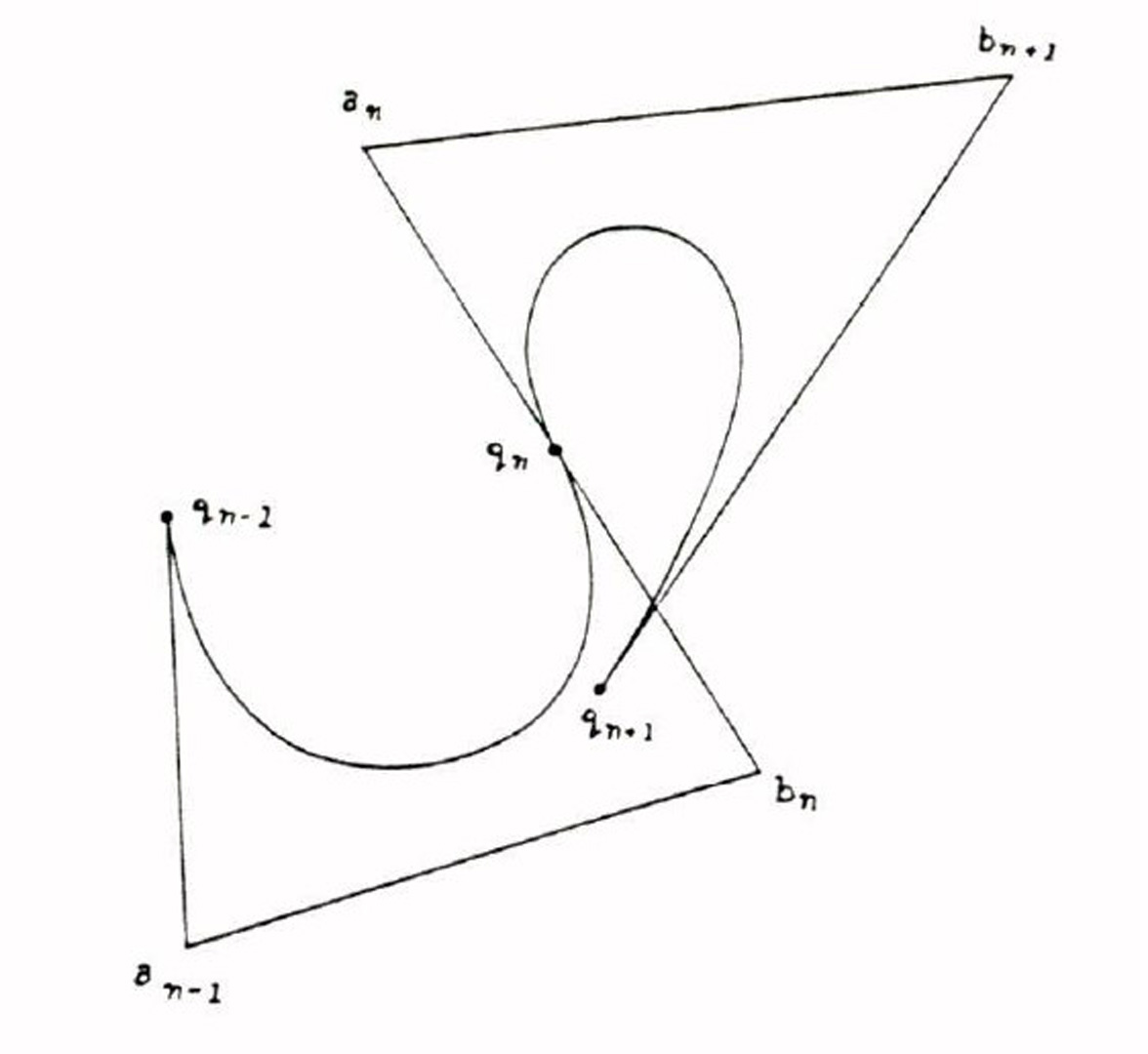“Animating rotation with quaternion curves” by Shoemake
Conference:
Type(s):
Title:
- Animating rotation with quaternion curves
Presenter(s)/Author(s):
Abstract:
Solid bodies roll and tumble through space. In computer animation, so do cameras. The rotations of these objects are best described using a four coordinate system, quaternions, as is shown in this paper. Of all quaternions, those on the unit sphere are most suitable for animation, but the question of how to construct curves on spheres has not been much explored. This paper gives one answer by presenting a new kind of spline curve, created on a sphere, suitable for smoothly in-betweening (i.e. interpolating) sequences of arbitrary rotations. Both theory and experiment show that the motion generated is smooth and natural, without quirks found in earlier methods.
References:
1. BEZlER, P.E., Numerical Control Mathematics and Applications, John Wiley and Sons, London 0o72).
2. BOEHM, WOLFGANG, “Inserting new knots into }3- upline curves,” Computer-Aided Design 12(4)pp. 199-201 (July 1980).
3. BRADY, MICHAEL, ‘:Trajectory Planning,” in Robot Motion: Planning and Control~ ed. Michael Brady, John M. Hollerb~ch, Timo~,hy L. Hohnson, Tomas Loz~no-Perez and Matthew T. Mason,The MIT Press (1982).
4. BROU, PHILIPPE, “Using the Gaussian l:mage to Find the Orientation of Objects,” The International Journal of Robotics Research 3(4) pp. 89-125 (Winter 1984).
5. CAYLEY, ARTHUR, “On certain results relating to quaternions,” Philosophical Magazine xxvi pp. 141-145 (February 1845).
6. COURANT, R. AND tIILBERT, D., Method8 o} Mathematical Physics, Volumv I, Interscience Publishers, Inc., New York (1953).
7. DAHLQUIST, GERMUND AND BJORCK, AKE, Numerical Methods, Prentice-Hall, Inc., Englewood Cliffs, N.J. (1974). Translated by Ned Anderson.
8. EULER, LEONHARD, “Decouverte d’un nouveau principe de m6canique (1752),’* pp. 81-108 in Opera crania, Ser. secunda, v. 5, Orell Fiisii Turici, Lausannae (1957).
9. EULER, LEONHARD, “Du mouvement de rotation des corps solides uutour d’un axe v~riable (1758),” in Opera crania, Set. secunda, v. 8, Orelt F iisli Turici, Lausannae ().
10. GABRIEL, STEVEN A. AND KAJIYA, JAMES T., “Spline Interpolation in Curved Manifolds,” , (1985). Submitted
11. GARDNER, MARTIN, New Mathematical Diversions from Scientific American, Fireside, St. Louis, Missouri (1971). Chapter 2
12. GOLDSTEIN, HERBERT, Classical Mechanics, second ~ditiou, Addison-Wesley Publishing Company, Inc., Reading, Mus~. (1980). Chapter 4 ~nd Appendix B.
13. GORDON, WILLIAM J. haND RIESENFELD, RICHARI~ F., “Bernstein-B~zier methods for the computeraided design of free-form curves and surfaces,” J. ACM 21(2) pp. 293-310 (April 1974).
14. GORDON, WILLIAM J. AND I~IESENFELD, RICtIARD F., “B-spline curves and surfaces,” in Compute, Aided Geometric Design, ed. Robert E. Barnh}ll and Richard F. Riesenfeld,Academic Press, New York (1974).
15. HAMILTON, SIR WILLIAM ROWAN, “On quaternions; or on a new system of imaginaries in algebra,” Philosophical Magazine xxv pp. 1%13 (July 1844).
16. HERSTEIN, I.N., Topics in Algebra, second edition, John Wiley and Sons, Inc., New York (1975).
17. KANE, THOMAS R., L1KINS, Pt~TER W. AND LEvi}N- SON, DAVID A., Spacecraft Dynamics, McGraw-Hill, ~n~. (10s3).
18. LANE, JEFFREY M., CARPENTER, LOREN C., WH|TTED, TURNER, AND BLINN~ JAMES F.~ “Scan line methods for displaying parametrically defined surfaces,” Comm. ACM 23(1)pp. 23-34 (January 1980).
19. MACLANE, SAUNDERS AND BIRKHOFF, GARRETT, Algebra, second edition, Mucmillaii Publishing Co., Inc., New York (1979).
20. MISNER, CHARLES W., THORNE, KIP S., AND WHEELER, JOHN ARCHIBALD, Gravitation, W.H. Freeman and Company, San Francisco (1973). Chapter 41 Spinors.
21. MITOHEI,L, E.E.L. AND ROGERS~ A.E., “Quaternion Parameters in the Simulation of a. Spinning Rigid Body,” in Simulation The Dynamic Modeling of Idea~ and Systems with Computers, ed. John McLeod, P.E., (1988).
22. NEWMAN, WRLIAM M. AND SPROULL, ROBERT F., Principles of Interactive Computer Graphics, second edition, McGraw-Hill, Inc., New York (1079). Chapter 21 Curves ~nd surfaces.
23. PICKERT, G. AND STEINER; H.-G., “Chapter 8 Complex numbers and quaternions,” in Fundamentals of Mathematics, Volume I ~ Foundations of Mathematics: The Real Number System and Algebra, ed. H. Behnke, F. Bachrnann, K. Fladt, and W. S{iss, (1983). Translated by S.H. Gould.
24. SCIIMEIDLER, W. AND DREETZ, W., “Chapter 11 Functional analysis,” in Fundamentals of Mathematics, Volume 11} ~ Analysis, ed. H. Behnke, F. Bachmann, K. Fladt, and W. Sfiss,MlT Press, Cambridge, Muss. (1983). Translated by S.H. Gould.
25. SCHOENBERG, I.J., “Contributions to the problem of approxima$ion of equidistant data by analytic functions,’~ Quart. Appf. Math. 4 pp. 45-99 and ,12-141 (1946).
26. SMITH, AI,~Y RAY, “Spline tutorial note~,” Technical Memo No. 77, Computer Graphics Project, Lucasfilm Ltd. (May 198a).
27. S05$, W., GERICKE, H., AND BERGER, K.H., “Chapter 14 ~ Differential geomeery of curves and surfaces,” in Fundamentals of Mathematics, Volume II Geometry, ed. l-l.’Behnke, F. Bachmann, K. Fladt, and W. ${iss,M{T Press (1983). Translated by S.H. Gould.
28. TAYLOR, RUSSELL H., “Planning and Execution of Straight Line Manipulator Trajectories,” in Robot Motion: Planning and Control, ed. Michael Brady, John M. Hollerbach, Timothy L. Hohnson, Tomas Lozano-Perez and Matthew T. Mason,The h/liT Press (1982).




